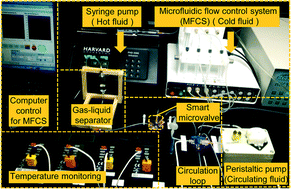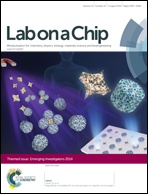A simple strategy for in situ fabrication of a smart hydrogel microvalve within microchannels for thermostatic control†
Abstract
Self-regulation of temperature in microchip systems is crucial for their applications in biomedical fields such as cell culture and biomolecule synthesis as well as those cases that require constant temperature conditions. Here we report on a simple and versatile approach for in situ fabrication of a smart hydrogel microvalve within a microchip for thermostatic control. The thermo-responsive hydrogel microvalve enables the “on–off” switch by sensing temperature fluctuations to control the fluid flux as well as the fluid heat exchange for self-regulation of the temperature at a constant range. Such temperature self-regulation is demonstrated by integrating the microvalve-incorporated microchip into the flow circulation loop of a micro-heat-exchanging system for thermostatic control. Moreover, the microvalve-incorporated microchip is employed for culturing cells under temperature self-regulation. The smart microvalve shows great potential as a temperature controller for applications that require thermostatic conditions. This approach offers a facile and flexible strategy for in situ fabricating hydrogel microvalves within microchips as chemostats and microreactors for biomedical applications.

- This article is part of the themed collection: 2014 Lab on a Chip Emerging Investigators

 Please wait while we load your content...
Please wait while we load your content...